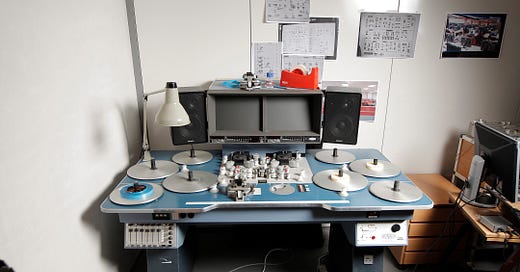Welcome to Mental Bric-a-Brac, a demo reel of scattered and impulsive thoughts swept from the floor of the editing room in my head.
You Haven’t Seen a Movie
If you're under 35 you have never actually seen a movie. You've been to something called a movie theater, but you haven't seen a movie.
You've seen a cheap, low resolution, terrible-color video projection.
You can't imagine what movies used to look like when they were on film. Yes, film prints got worn out and some theaters did a bad job.
But no, it's not true that "movies all looked terrible." That's Millennial and younger false ideas about how "bad" all past technology was. When I show young people a black and white photograph or portrait from 1940 that’s so clear and sharp that you’d think you were looking out a window, they’re baffled. Isn’t, like, all old stuff, like, really bad?
No, Virginia. Film wasn’t like, “really bad.” It was like, extraordinarily good. You believe an inversion—that “digital” means “prettier and better because LOL new!”
Movies today look like what they are—digital video. They look like soap operas, not cinema. Not only is the capture method inferior to the resolution and color depth of motion picture film, but the projection quality is significantly lower, too.
Movies today have the worst color I have ever seen, and I have watched movies from the turn of the 20th century until today (film student in college). It’s horrendous. Everything is washed out, as if they sat down at a digital editing suite and pressed the Millennial Gray “filter.”
I’m so irritated at what kids think a “filter” is. They think it’s a complicated digital algorithm that puts cat ears on you. I’m certain not 10 percent of them know that, just yesterday, it actually meant a real, physical-in-the-3d-world, piece of glass that went in front of a camera lens.
This is what I used to edit my college films on (16 mm motion picture stock):
It’s called a Steenbeck, and it was miles better than the shitty upright Movieola editing machines Hollywood insisted on, probably because of some contract with the mob and manufacturer.
The machine was great to work on, and allowed easy viewing of the frames, fine speed control, and it was gentle on film. Deep finger cuts were a hazard; you cut film with a guillotine device. I went to the emergency room once having sliced down through my thumbnail.
Dissolves, cuts, fades, and audio soundtrack cues were all marked on the working film print itself in grease pencil using symbolic conventions. The work print went the wet lab. They would take your negatives and load them into an optical printer, creating a new negative with a soundtrack embedded based on the edit markings on your work print.
So, you haven’t seen a movie. You’ve seen a video.
The Windsors Could Save England But They Won’t
This will sound like ridiculous fantasy, I know, and it is a fantasy, but it is not ridiculous. I genuinely believe that if the following happened, it would save Britain. As an amateur student of late medieval and early modern Britain (ca 1400 to 1603), it’s obvious how Machiavellian and brutal the royal and aristocratic systems were. But even the most grasping monarchs and pretenders, for the most part, believed they had a sacred duty from God to their kingdom and to their people. There isn’t a single royal or politician today who has any such sense of duty.
But what if the Windsors did, and what if they did this?
Keep reading with a 7-day free trial
Subscribe to Disaffected Newsletter to keep reading this post and get 7 days of free access to the full post archives.




